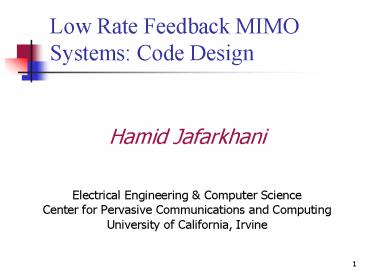Low Rate Feedback MIMO Systems: Code Design PowerPoint PPT Presentation
1 / 35
Title: Low Rate Feedback MIMO Systems: Code Design
1
Low Rate Feedback MIMO Systems Code Design
- Hamid Jafarkhani
- Electrical Engineering Computer Science
- Center for Pervasive Communications and Computing
- University of California, Irvine
2
Outline
- Introduction
- VQ-Based Beamforming
- Transmit Beamforming for Time-Selective Fading
Channels - Transmit Beamforming for MIMO-OFDM Wireless
Systems - Noisy Feedback Channels
- Conclusions
3
Open-loop
Feedback
Close-loop
4
Different Types of Feedback in a Close-loop System
- Perfect feedback
- Mean/Covariance feedback
- Average SNR information
- Quantized phase/magnitude feedback
- Quantized direction feedback
5
Block Diagram of a Transmit Beamforming System
Bit stream for Ant-1
Input Bits
Encoder
Bit Stream for Ant-2
Receiver
Transmitter
Receiver
6
Shortcomings of Channel Feedback from Receiver
- Channel estimation error at the receiver
- Quantization loss
- The delay between estimation time and the time
that feedback is used - Noise in the feedback channel
7
Channel Feedback Quality
- If the feedback quality drops too low, the
beamforming scheme should gradually fall back to
the non-beamformed scheme. - Perfect Channel Feedback Beamforming
- No Channel Feedback Space-Time Coding
- What shall we do in between?
8
Linear beamforming scheme for STBCs
Feedback CSI
STBC Encoder (OSTBC/QSTBC)
Multiply with Beamforming Matrix P
Channel Estimation Linear Proc.
Input Bits
CPC
Decoded Bits
9
Advantages and Disadvantages
- Performance improvement through optimal power
loading - Complicated implementation (eigen-analysis)
- Beamforming matrix renders high PAPR
- trellis state machine and beamforming scheme
should be jointly defined
10
A Simplified SOSTTC Beamforming Scheme
11
CPSTTC System Block Diagram
- Based on the channel phase information, the
proper inner code is selected - A standard M-TCM structure is used as the outer
code
12
Rate-Limited FeedbackSystem Block Diagram
Feedback Channel
Codebook
Index
Multiply with Transmit Weight
Select Transmit Weight From Codebook
Base Band Single Data Stream
Input Bits
Dec
Codebook
13
VQ-Based Beamforming
A generalized Lloyd algorithm or a Grassmannian
method can be utilized to design the beamformer
14
Time-Selective Fading
- Previous work was based on quasi static i.i.d.
block fading - Time-Selective Fading Jakes model
- Simplification of Jakes model with AR1
15
Beamforming Design for Time-Selective Fading
Channels
- Predictive Vector quantization (PVQ) quantize
the residue signal instead of the actual channel
direction - Successive Beamforming (SBF) the beamforming
codebook is adjusted based on the transmit weight
from the previous frames.
16
PVQ Beamformer
- Designing VQ for a Gauss-Markov source
- Designing the residue generator and
reconstruction units - Designing the optimal predictor
- To min the given distortion (max SNR)
17
PVQ Encoder
Complex Householder transformation House(y) is a
unitary matrix with the first column being y
18
PVQ Decoder
- Theorem The linear coefficients that accomplish
the highest predictor SNR is a simple delay unit
19
PVQ Beamformer Properties
- Very good performance
- Even better performance is possible by using
higher order predictors (ARMA) - Codebook is a function of fading speed and the
number of antennas - Convergence of the design algorithm is not
guaranteed (converges for large N)
20
SBF System Block Diagram
Feedback Channel
Delay
Codebook Ct
Index
Multiply with Transmit Weight
Select Transmit Weight From Codebook
Base Band Single Data Stream
Input Bits
Dec
Codebook Ct
Delay
21
Successive Beamforming (SBF)
- Codebook is a function of time Ct
- Beamformer has memory
- Synchronized codebook update on both sides
without extra feedback information - Flexible implementation No need to have a
different codebook for a different fading speed
22
SBF Codebook Construction
- Proposition At the t th frame, the SBF codebook
is generated as - where
- are constant vectors with unit norm e1 1 0
0T
23
Numerical Simulations SNR performance
- Nt 4, 2N16 MISO system
- PVQ beamformer provides best performance
- SBF algorithm is close to PVQ beamformer.
- Both are far better than memoryless Grassmannian
beamformer
24
Numerical Simulation BER performance
- Nt 4, 2N16. WCDMA system parameters
- PVQ beamformer provides best performance.
- SBF algorithm is close to PVQ beamformer.
- Performance gain is larger at slow fading speed
and smaller SNR. - Both are better than memoryless Grassmannian
beamformer.
25
Frequency-Selective Fading
26
System Model
- Channel taps Exponential power decay
- Doppler shift on L channel taps AR1 fading model
27
Existing OFDM Beamformers
- Independent beamforming on each subcarrier using
memoryless Grassmannian codebook. - Huge feedback bits Bad performance
- Spherical linear interpolator OFDM beamformer
- Less feedback bits Worse performance
28
Our Approach
- Exploit the time domain and frequency domain
correlations. - Transmit beamforming based on successive
beamforming (SBF).
29
Time Domain Round Robin SBF
30
Frequency Domain Round Robin SBF
31
Frequency Domain Cluster SBF
32
Numerical Results (IEEE 802.11a)
- TDRSBF and FDRSBF outperform full feedback
Grassmannian beamformer. (40 bits gt 192 bits,
only 1dB away from perfect CSI). - FDRSBF algorithm is affected by channel delay
spread. Whereas TDRSBF is insensitive to channel
delay spread.
Hiperlan2 Indoor fading model C (Trms 150ns,
v3m/s)
33
Numerical Results (Ergodic Capacity)
- TDRSBF and FDRSBF outperform full feedback
Grassmannian beamformer (FFGBF). (40 bits gt 192
bits, 0.5dB from perfect CSI).
Hiperlan2 Indoor fading model A (Trms 150ns,
v3m/s)
34
Results
- We have developed beamforming algorithms to
exploit the mutual correlation in the fading
channel. The proposed algorithms have very
limited feedback requirements. - The TDRSBF algorithm is sensitive to mobile
Doppler shift. It performs well at slow fading
scenarios. - The FDRSBF algorithm is more severely affected by
channel delay spread rather than mobile Doppler
shift. It performs better than the TDRSBF
algorithm at fast fading or small delay spread
environments.
35
Conclusions
- A VQ-based beamformer framework is general enough
to deal with different scenarios - We have designed VQ beamformers for
- Time-selective channels
- Frequency-selective channels
- Noisy feedback channels
- Can be combined with space-time coding

